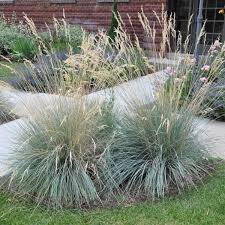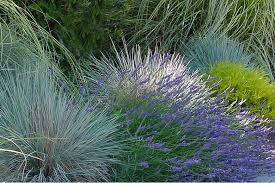Blue Oat Grass, scientifically known as Helictotrichon sempervirens, is a captivating ornamental grass that adds a touch of elegance to gardens and landscapes. With its striking blue-gray foliage and graceful arching growth habit, Blue Oat Grass is a popular choice among gardeners and landscapers alike.
This perennial grass is native to the Mediterranean region and belongs to the Poaceae family. Its unique blue coloration sets it apart from other grass varieties, making it a standout choice for creating visual interest and contrast in gardens. The leaves of Blue Oat Grass are narrow and linear, resembling oat leaves, which is how it got its name.
One of the notable features of Blue Oat Grass is its adaptability to various soil types, including well-drained and even slightly rocky soils. This resilience makes it a versatile option for different garden settings, from coastal landscapes to mountain gardens. Additionally, Blue Oat Grass is drought-tolerant once established, making it a low-maintenance addition to your outdoor space.
In late spring and early summer, Blue Oat Grass produces tall flowering stems that bear delicate panicles of oat-like spikelets. These airy flower heads sway gracefully in the breeze, adding movement and a sense of liveliness to the garden. The flowers start off a greenish color and mature into a lovely shade of golden brown, creating a visually pleasing contrast against the blue foliage.
To make the most of Blue Oat Grass in your garden, consider planting it in groups or as a border along pathways. Its compact size, reaching around 2 to 3 feet in height and spread, allows for easy integration into various garden designs. Pairing Blue Oat Grass with other drought-tolerant plants and succulents can further enhance its beauty and create a cohesive landscape.
Caring for Blue Oat Grass is relatively straightforward. It thrives in full sun to partial shade and requires minimal pruning. Trim any dead or damaged leaves in late winter or early spring to encourage healthy new growth. While Blue Oat Grass is generally low-maintenance, occasional watering during dry periods can help keep it looking its best.
In addition, Blue Oat Grass is a remarkable ornamental grass that brings a touch of tranquility and charm to gardens and landscapes. Its distinctive blue-gray foliage, graceful form, and adaptability make it a sought-after choice for both novice and experienced gardeners. By incorporating Blue Oat Grass into your outdoor space, you can create an enchanting and picturesque setting that will be admired by all who visit.
Read Also: German Shepherd Dogs Description and Complete Care Guide
Growing and Care Guide of Blue Oat Grass

Below are the growing and care guide for Blue Oat Grass (Helictotrichon sempervirens):
1. Location and Soil: Choose a sunny to partially shaded spot in your garden for planting Blue Oat Grass. It thrives in well-drained soil, so make sure the area has good drainage to prevent waterlogging. It can tolerate a variety of soil types, including sandy or slightly rocky soils.
2. Planting: Plant Blue Oat Grass in the spring or fall. Dig a hole slightly larger than the root ball of the plant and place it at the same depth it was in the nursery container. Fill in the hole with soil and pat it down gently to remove air pockets. Space multiple plants about 2 to 3 feet apart to allow for their mature size.
3. Watering: While Blue Oat Grass is drought-tolerant once established, regular watering is important during the first growing season to help the plant establish strong roots. Water deeply but infrequently, allowing the soil to dry out between waterings. Once established, water during dry periods to keep the plant looking its best.
4. Mulching: Applying a layer of organic mulch around the base of the plant can help conserve soil moisture and suppress weed growth. Keep the mulch away from the crown of the plant to prevent moisture-related issues.
5. Pruning: Blue Oat Grass is relatively low-maintenance when it comes to pruning. In late winter or early spring, trim any dead or damaged leaves near the base of the plant. This will encourage new growth and keep the plant looking tidy.
6. Fertilizing: Blue Oat Grass doesn’t require heavy fertilization. You can apply a balanced, slow-release fertilizer in the spring to promote healthy growth. Avoid over-fertilizing, as this can lead to excessive foliage growth at the expense of the plant’s natural form.
7. Dividing: After a few years, Blue Oat Grass may become crowded and less vigorous. Dividing the plant every 3 to 4 years can help rejuvenate its growth. Dig up the plant in early spring before new growth begins, divide the clump into smaller sections, and replant the divisions in well-prepared soil.
8. Pests and Diseases: Blue Oat Grass is generally resistant to most pests and diseases. However, keeping an eye out for common garden pests like aphids and checking for any signs of disease is still recommended. Promptly address any issues that may arise.
9. Winter Care: Blue Oat Grass is hardy in most regions and can tolerate cold temperatures. In areas with harsh winters, you can apply a layer of mulch around the base of the plant to provide some insulation.
10. Landscape Uses: Blue Oat Grass is versatile and can be used in various landscaping settings. It works well as a border plant, in rock gardens, or as an accent plant in containers. Its unique blue color and graceful form add texture and interest to your garden design.
By following these simple growing and care guidelines, you can enjoy the beauty of Blue Oat Grass in your garden while keeping it healthy and thriving throughout the seasons.
Read Also: Pembroke Welsh Corgi Dogs Description and Complete Care Guide
Importance of Blue Oat Grass

The importance of Blue Oat Grass (Helictotrichon sempervirens) lies in its numerous contributions to gardens, landscapes, and ecosystems:
1. Aesthetic Appeal: Blue Oat Grass adds a striking and unique aesthetic to gardens and landscapes with its captivating blue-gray foliage. Its distinct color and graceful form create visual interest and contrast, making it a standout feature in various outdoor settings.
2. Texture and Movement: The airy flower heads of Blue Oat Grass sway gracefully in the breeze, introducing movement and a sense of liveliness to the garden. This gentle movement adds a dynamic element that enhances the overall beauty and atmosphere of the landscape.
3. Low-Maintenance Landscaping: Blue Oat Grass is a low-maintenance plant once established. Its adaptability to various soil types and drought tolerance make it an excellent choice for sustainable landscaping. It requires less water and maintenance compared to many other ornamental plants.
4. Erosion Control: In areas where soil erosion is a concern, Blue Oat Grass can play a role in stabilizing the soil due to its extensive root system. It helps prevent soil erosion and runoff, contributing to the overall health of the ecosystem.
5. Wildlife Habitat: While Blue Oat Grass may not be a primary source of food for wildlife, its presence in gardens and landscapes can provide shelter and habitat for small animals, insects, and beneficial organisms. These creatures contribute to the overall ecological balance.
6. Diversity in Plantings: Incorporating Blue Oat Grass into garden designs adds diversity to plantings, offering an alternative to more common green foliage. Its unique color and texture create a harmonious blend with other plants, contributing to a balanced and visually appealing landscape.
7. Educational Value: Blue Oat Grass can be used as an educational tool to showcase different types of plants and their adaptations. Its characteristics, such as drought tolerance and distinctive color, can serve as points of discussion and learning in horticultural and ecological contexts.
8. Economic Benefits: For landscaping businesses, nurseries, and horticultural enthusiasts, Blue Oat Grass presents an opportunity for cultivation, sale, and propagation. Its popularity among gardeners adds to its economic importance within the horticulture industry.
9. Cultural Significance: In some regions, Blue Oat Grass might hold cultural or symbolic significance, possibly due to its color or historical uses. It can contribute to local traditions, aesthetic preferences, and community identity.
In summary, the importance of Blue Oat Grass extends beyond its ornamental beauty. It plays a role in sustainable landscaping, ecological balance, and even educational endeavors. Whether used as a standalone focal point or as part of a diverse planting scheme, Blue Oat Grass enriches outdoor spaces and contributes to the well-being of both nature and people.
Read Also: How Puramino Can Enhance And Elevate Your Baby’s Health
